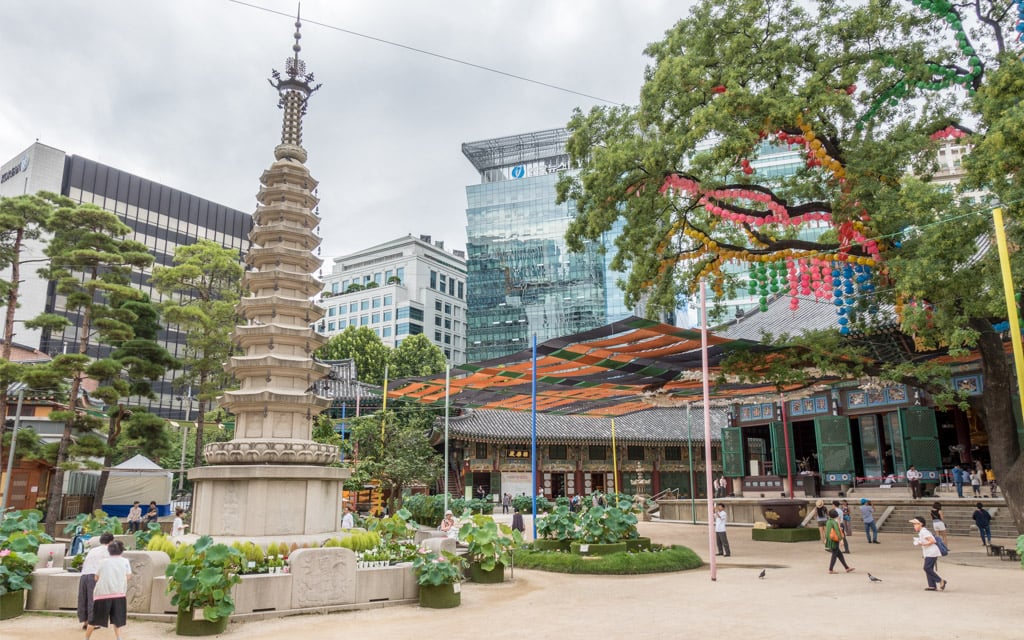
Jogyesa Temple is one of the most important Buddhist temples in Korea and a symbol of Korean Buddhism. It is located in the heart of the city near Insadong. Since 1936, it has been the head temple of the first district of the Jogye Order of Korea Buddhism.
The temple was first established in 1395, at the start of the Joseon Dynasty. The modern temple was established in 1910 and was originally located at a different location. At this time, the temple was known as Gakhwangsa.
In 1937, it was moved to its current location where it was reconstructed. Construction was completed on October 25, 1938.
At this time, the temple was known as Taegosa. This was during the Japanese occupation of Korea (1910-1945). The name stayed the same until 1954.
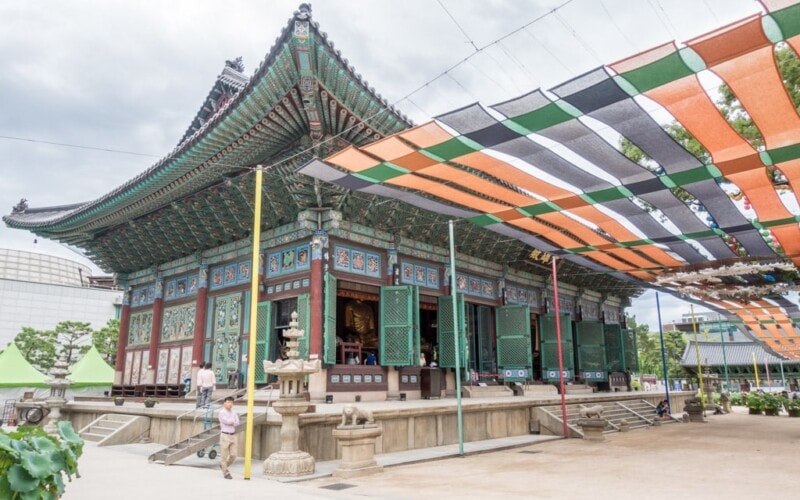
After liberation, in 1954, the Buddhist Purification Movement was established. The goal of the movement was to eliminate any residual Japanese influence from their occupation. That same year, the temple was renamed to Jogyesa. This was a way for Korea to move on and forget the past horrors of the Japanese occupation.
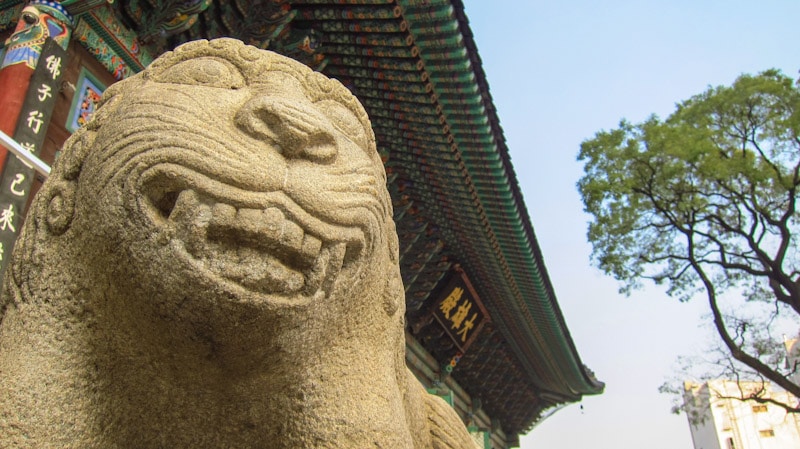
In late 1998, Jogyesa was occupied by monks taking part in a protest and power struggle between the Jogye Order organization. After 40 days, riot police were called in to expel the protesters. The story made international headlines.
Today, Daeungjeon (Main Dharma Hall) is the largest temple building in the city of Seoul and on its own is a spectacular and colorful sight for any visitor.
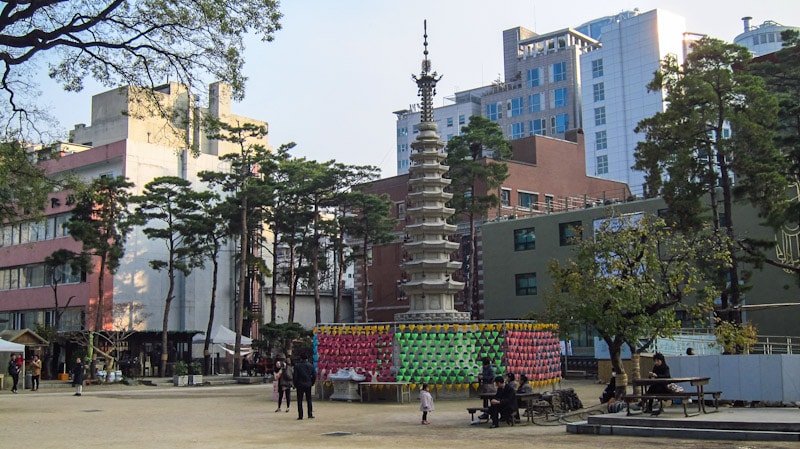
Visitors here will be surprised to find a beautiful setting and sense of calmness in the middle of the hectic and crowded city. The grounds are a great escape from the big city for both locals and tourists. Some of the nature that is not to be missed include a rare 500 year old Baeksong lacebark pine tree and a 450 year old Chinese scholar tree.
Jogyesa Temple may not be the most beautiful or grand grounds in Korea, but its strength lies in its convenient location makes it one the most visited and popular temples in central Seoul.
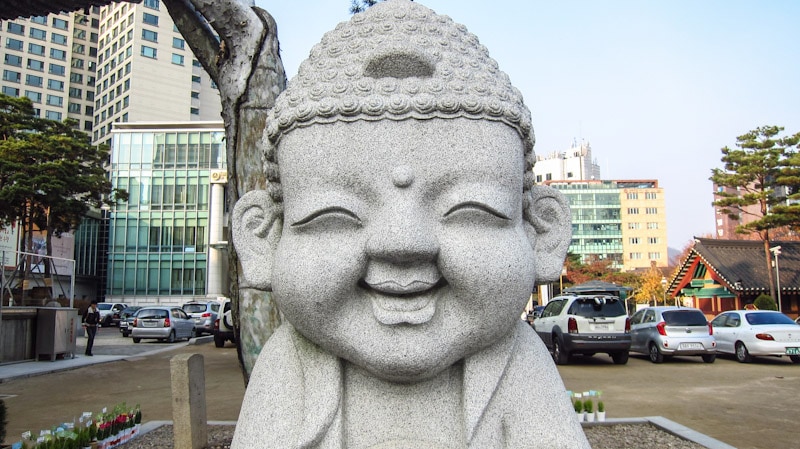
Located around the temple grounds are a variety of stores and shops that specialize in Buddhist items that make for great souvenirs. Items include small Buddha statues, prayer beads, small wooden gongs, monks’ clothing, and incense. Even if you are not planning to do any shopping, these shops are a great place to browse and see interesting and unique items.
The best times to visit Jogyesa Temple are Buddha’s birthday or during the Lotus Lantern Festival when the courtyard of the temple is decorated with paper lanterns.
Daeungjeon (Main Dharma Hall)
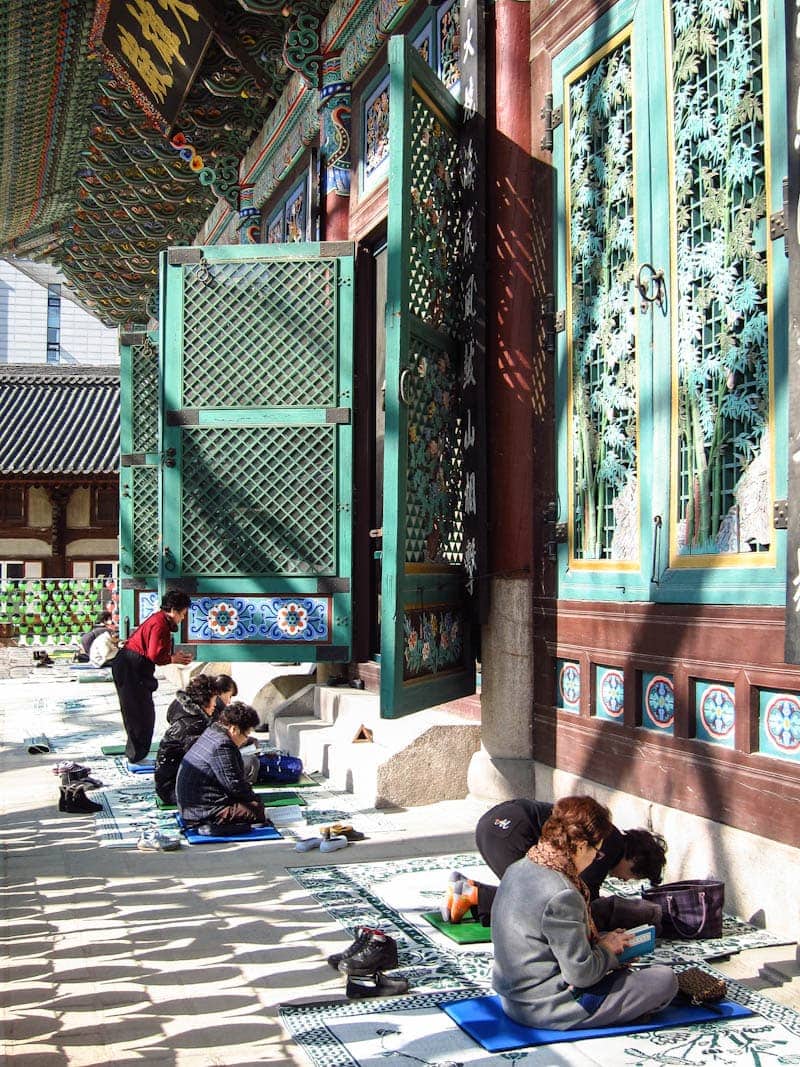
Daeungjeon (Main Dharma Hall) is located at the center of Jogyesa Temple. It is named after Shakyamuni Buddha, whose golden statue is found inside. The building opened in 1938. In 2000, the hall was designated as an important cultural asset of Korea.
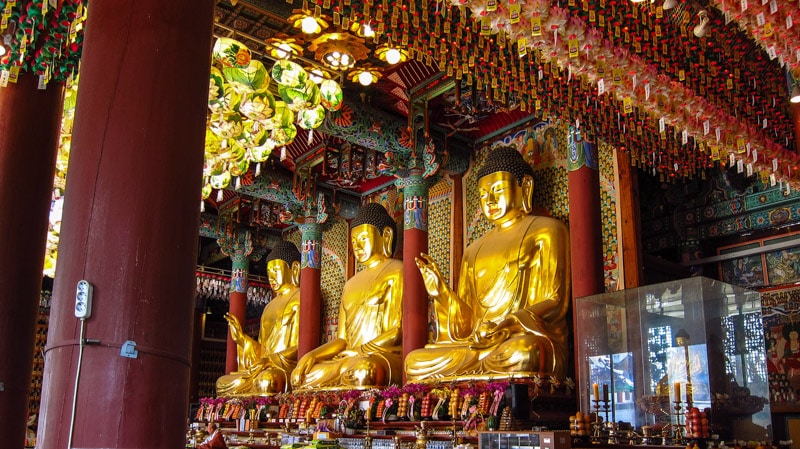
When you walk inside, the first thing you will notice are the magnificent golden statues of Amitabha Buddha, Shakyamuni Buddha, and Bhaisaiya Buddha. These golden statues measure in at over 4.8 meters (16 feet) tall.
Shakyamuni, center, can be seen with his left hand in his lap while his right hand touches the ground with the tip of his finger. This is the symbolic gesture or mudra of Shakyamuni. It symbolizes him touching the earth after enlightenment.
Shakyamuni is also the founder of Buddhism and the great hero for which the hall is named after.
On the left is the statue of Amitabha Buddha. His mudra is to have his thumb and third finger of each hand touching. His name is chanted by those with hopes of being reborn one day into a situation of perfect enlightenment and truth.
On the right is Bhaisaiya Buddha. He brings good health and fortune to those who are suffering, both physically and emotionally. He is often seen holding a container of medicine to help those in need.
From 2002 to 2006, the building was renovated in part due to donations and help from the government.
Baeksong (Lacebark Pine Tree)
Baeksong is a 500 year old Lacebark Pine tree that is located at Jogyesa Temple. It features a distinctive and beautiful brown bark. These types of trees grow and reproduce slowly making them very rare and important to the history of Korea.
Originally, it was located at Gakhwangsa Temple and then moved to its current location at Jogyesa Temple. It is located next to Daeungjeon (Main Dharma Hall).
In December 1962, the Korean government designated it as a Natural Monument.
A 450 year old Chinese Scholar Tree is located nearby.
Beomjongru (Brahma Bell Pavilion)
Beomjongru (Brahma Bell Pavilion) is a colorful building that houses four temple instruments which are played before morning and evening chanting. The four instruments are the Brahma Bell, Dharma Drum, Cloud Gong, and Wooden Fish.
Everyday, the Brahma Bell rings 28 times in the morning and 33 times in the evening, which is meant to save those from suffering in the world through the dharma.
The Dhara Drum, Wooden Fish, and a metal Cloud Gong are meant to save those on land, in the sea, and in the sky and space.
The design of the building and the different colors are a very beautiful sight. You can walk up the stairs to get a close up view of the building and of the instruments housed inside.
Chinese Scholar Tree
The Chinese Scholar Tree is located next to Daeungjeon (Main Dharma Hall). It belongs to the pea family and is believed to be over 450 years old. It is 26 meters (85 feet) tell with a circumference of 4 meters (13 feet).
It August, it produces creamy white blossoms. During the fall, it produces strings of bead shaped fruit. In the winter, all the leaves fall off. In the spring, beautiful green leaves will begin to grow once again.
Often found planted near Buddhist temples and palaces, they are believed to convert negative energy into positive energy and happiness.
A 500 year Baeksong (Lacebark Pine Tree) is located just nearby.
Geuknakjeon (Paradise Hall)
Geuknakjeon (Paradise Hall) was built in honor of Amitabha, a celestial Buddha. He lead people to the ultimate enlightenment, where he now resides. This hall is one of the newest and most modern at Jogyesa Temple.
Amitabha Buddha is the principal Buddha in a type of Buddhism practiced in East Asia known as Pure Land Buddhism. Amitabha means “Infinite Light.” Therefore, other names for this building include Hall of Infinite Life and Hall of Light and Life.
There are also ten statues found here. These statues are the judges that decide 49 days after death who goes to heaven and who goes to hell.
Today, this building is used for ceremonies, prayer services, funerals, and dharma talks.
Iljumun (One Pillar Gate)
Iljumun (One Pillar Gate) is the colorful and large main gate into holy Jogyesa Temple. Daeungjeon (Main Dharma Hall), can be seen in the background. The name derives from the single, horizontal post, which symbolizes one mind. It is said that when people walk through, all scattered minds become one.
The signboard at the top of indicates the status of the Jogyesa as being the Head Temple of Korean Buddhism. The signboard was inaugurated in October, 2007.
After passing through the gate, you will arrive at large Daeungjeon (Main Dharma Hall) along with two trees which are over 450 years old, Baeksong (Lacebark Pine Tree) and the Chinese Scholar Tree.
Ten Story Buddha Relic Stupa
The Ten Story Buddha Relic Stupa houses a relic of the Buddha which was brought here by a monk after it was given to him by the royal court of Thailand.
The monk, Anagarika Dharmapala (1864-1933), was given the relic by the King of Thailand. Dharmapala then brought the relic to Korea and finally to Jogyesa Temple.
When the relic, or sarira, first arrived here, it was housed inside the dharma hall. At the time, Jogyesa Temple was known as Gakhwangsa Temple.
Jogyesa Temple Information
Hours
The temple grounds are open 24 hours.
Daeungjeon (Main Dharma Hall) and Geuknakjeon (Paradise Hall) are open 4:00-21:00.
Admission
Free
Address
55 Ujeongguk-ro, Jongno-gu, Seoul, South Korea
GPS Coordinates: 37.57387, 126.98258
How to Get Here
Option 1
Take Subway Line 3 to Anguk Station (Exit 6).
Continue for 140 meters and turn left at Ujeongguk-ro, just past Insadong-gil.
Continue for 190 meters to reach the temple on the right.
Option 2
Take Subway Line 1 to Jonggak Station (Exit 2).
Continue for 350 meters to reach the temple on the left.
Jogyesa Temple Video
Map
Additional Resources
Viator by TripAdvisor
Viator is a popular online platform that helps travelers book tours, activities, and unique experiences worldwide, including in Seoul. It connects users with a wide selection of options – from sightseeing tours to cultural events and outdoor adventures – all offered by local providers.
Klook
Klook offers discounted tickets and reservations for various attractions and services in Seoul, from theme parks and museums to tours and transportation options.
Rakuten
Save money while exploring Seoul with Rakuten's cashback program. Book your hotels or other services through Rakuten and enjoy cashback rewards and exclusive deals.
If you sign up using the link below, you could earn $30 cashback on your first purchase over $30.
Book Recommendations
For an immersive guide to Seoul, many travelers choose to bring a book along. Fodor's Seoul, for example, offers detailed recommendations on sights, restaurants, maps, and travel tips.
Nearby Sights
Ujeongchongguk (Central Post Office)
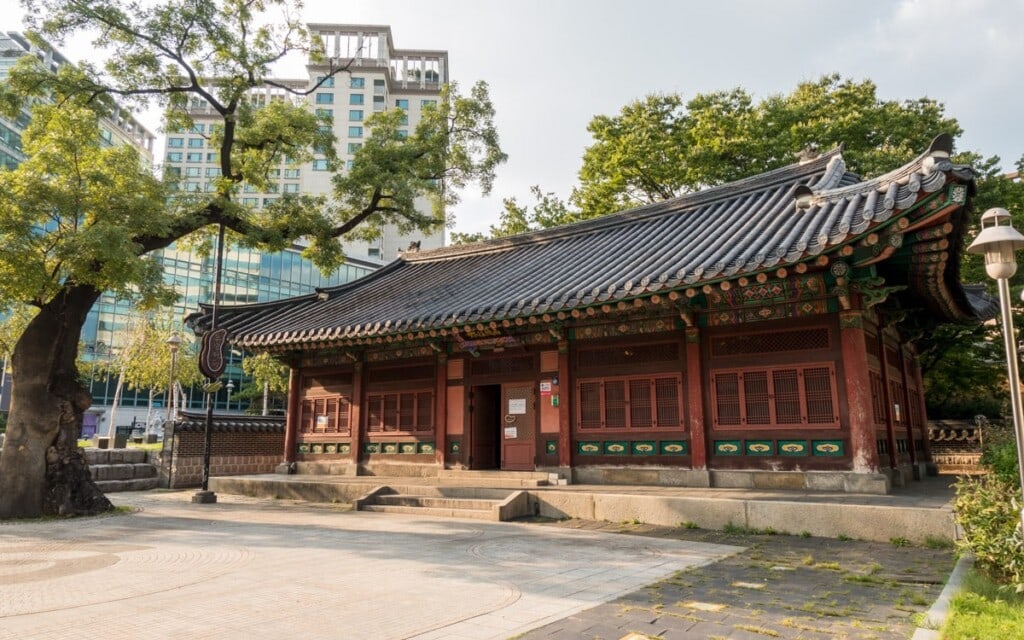
Ujeongchongguk (Central Post Office) was established as the first post office of Korea on April 22, 1884 during the reign of King Gojong. Postal service began on November 18, 1884. It was the first modern postal service. Service was suspended during the Gapsin Coup on December 4, 1884. Service was resumed on July 22, 1895. In 1904, a patriotic organization known as Boanhoe held a massive anti-Japan rally at this location.
Insadong
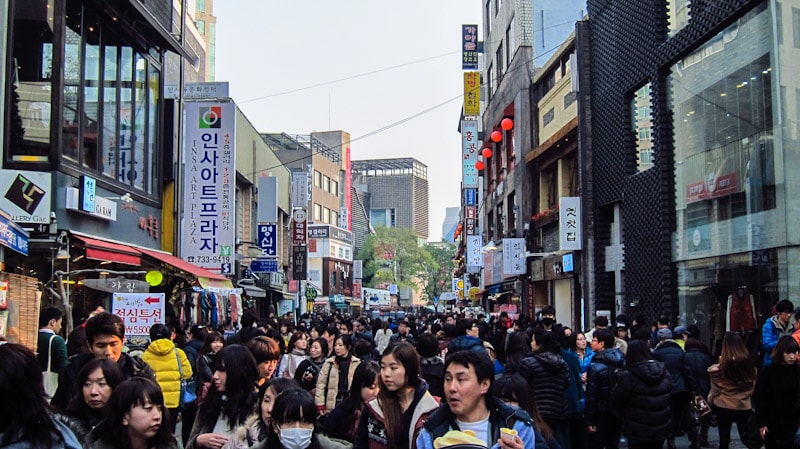
Insadong is a popular neighborhood in the heart of Seoul that is often visited by locals and tourists wanting to experience traditional culture of Korea. Streets and narrow back alleys are lined with art galleries, wooden tea houses, restaurants, cafes, and small shops selling arts and crafts. The main street, Insadong-gil, runs for 700 meters from Tapgol Park in the south to Anguk-dong Rotary.
Ssamzigil
Ssamziegil, also known as Ssamziegil, is a colorful shopping and culture complex in Insadong that features cafes, galleries, and workshops. The complex's design uniquely blends contemporary elements with traditional Korean charm. The complex opened in 2004 and is now a destination and an important centerpiece of Insadong. Ssamzigil may be modern, but its construction blends with the surrounding traditional neighborhood.
Cheondogyo Central Temple
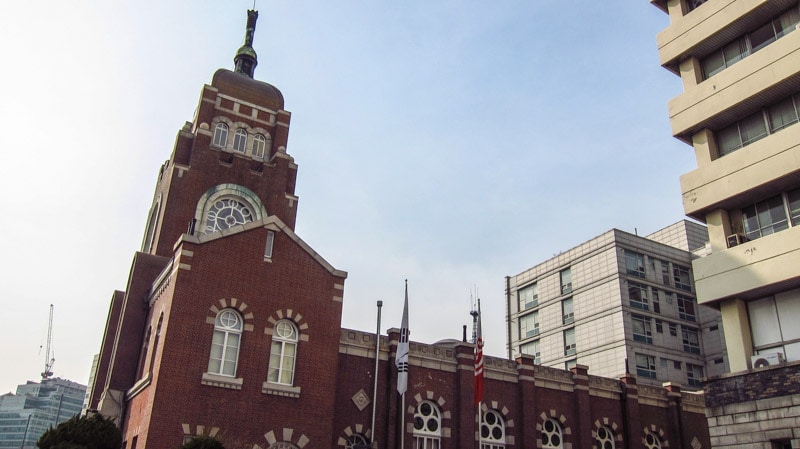
When Cheondogyo Central Temple was built between 1918 and 1921 it was used as a temple of Cheondoism, a 20th century Korean religious movement. Cheondogyo literally means "religion of the Heavenly Way." The roots of Cheondoism are based on the Confucian movement with an emphasis on Taoism, Buddhism, Korean nationalism, and ideas of peace, personal virtues, and morals while on earth.
Seungdong Presbyterian Church
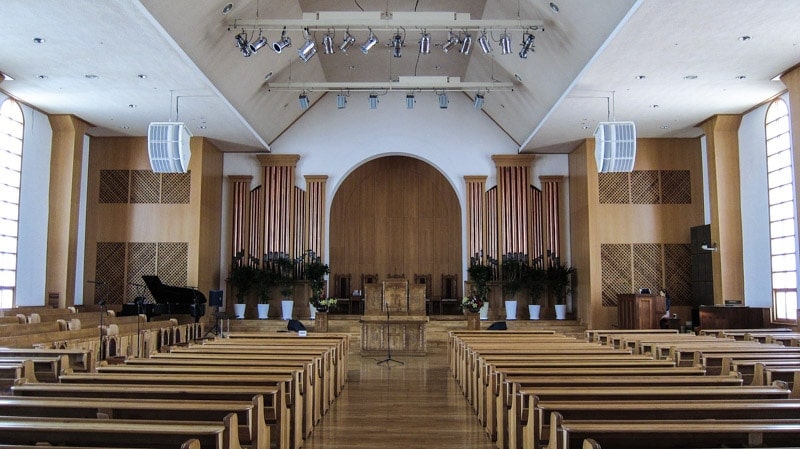
Seungdong Presbyterian Church, located near Insadong, was established in 1893 by Samuel Foreman Moore (1860-1906). Over the years, the church has been relocated and renamed many times. Before being renamed Seungdong, it has been known by as Gondanggol, Jungang, and Baekjeong. When the church was known as Baekjeong, meaning butchers, it attracted social underdogs and mysterious figures of the Joseon society.
Bosingak Belfry
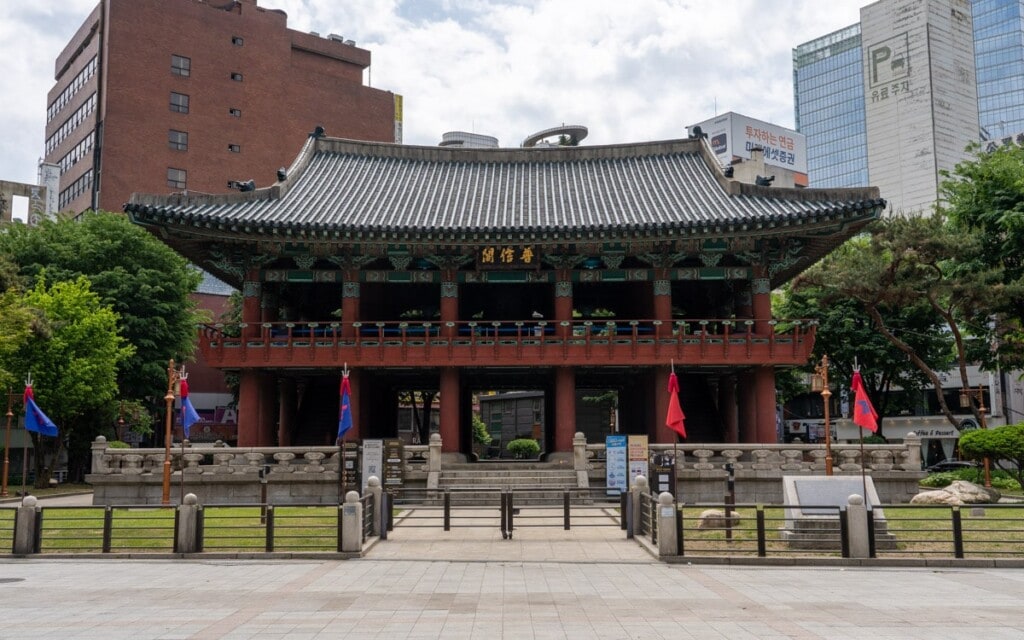
Located in the heart of Insadong is Bosingak Belfry. This historic bell pavilion, or bell tower, stands out in a sea of modern skyscrapers in the Jongno District. The Jongno District gets its name from Jongno, a major road which runs west to east through the heart of central Seoul.
Last Updated on Feb 11, 2025